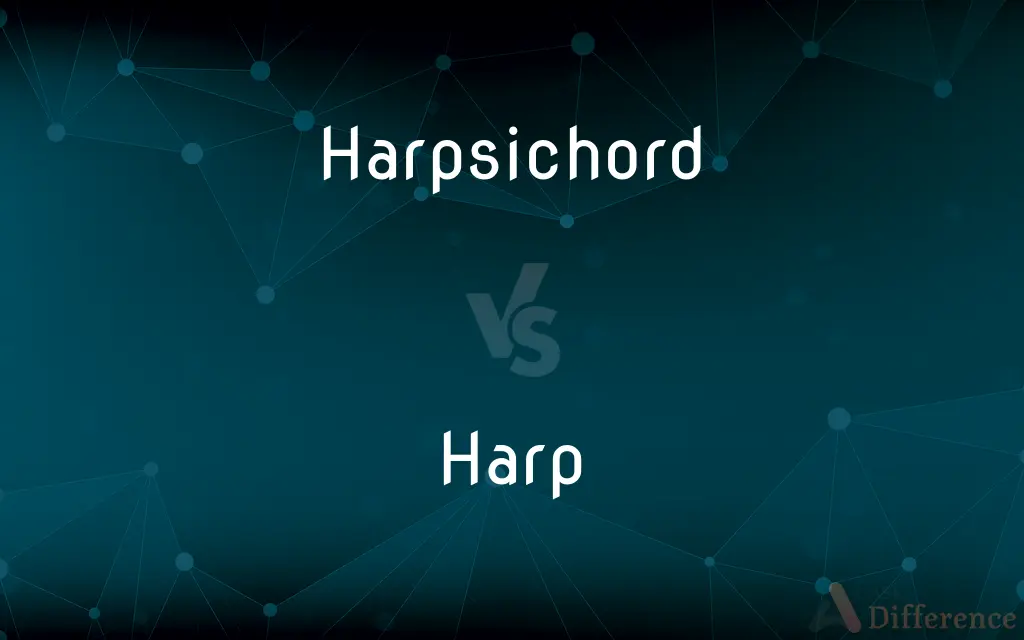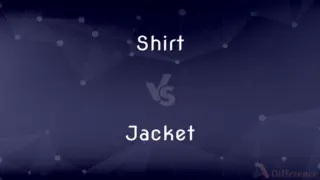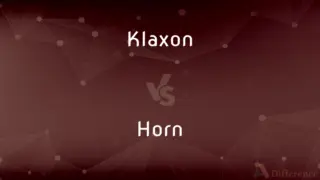Harpsichord vs. Harp — What's the Difference?
Edited by Tayyaba Rehman — By Fiza Rafique — Updated on April 2, 2024
A harpsichord produces sound by plucking strings when keys are pressed, while a harp generates tones through the direct plucking of strings with fingers.

Difference Between Harpsichord and Harp
Table of Contents
ADVERTISEMENT
Key Differences
The harpsichord is a keyboard instrument where sound is produced by plucking strings when keys are pressed. It is known for its distinctive, metallic timbre and was popular during the Renaissance and Baroque periods. Whereas the harp is a stringed instrument that is played by plucking the strings with the fingers, it lacks keys and can vary in size from small lap harps to large concert grand harps.
The harpsichord's mechanism involves a plectrum plucking the string when a key is depressed, a process that allows for little variation in the volume of sound produced. On the other hand, the harp allows for dynamic control through the strength of the pluck, offering a wide range of expression.
The harpsichord often serves a specific role in early music ensembles, providing a continuous harmonic foundation. In contrast, the harp is versatile, used in a variety of musical genres from classical to contemporary, and can play both harmonic and melodic roles.
Harpsichords are typically associated with formal, classical music settings and compositions from specific historical periods. Meanwhile, harps have found a place in a broader spectrum of music, including orchestral, folk, and even pop music.
The construction of a harpsichord includes a wooden case housing the keyboard and strings, with intricate decorations often adorning its exterior. Harps, with their unique shape and exposed strings, are visually striking and can be made from a range of materials, including wood, metal, and even carbon fiber for modern instruments.
ADVERTISEMENT
Compare with Definitions
Harpsichord
Features a wooden case with a keyboard, often decorated with intricate designs.
The museum's antique harpsichord was admired for its ornate exterior.
Harp
Has a broad history across many cultures, adaptable to various musical styles.
Folk traditions from different cultures have embraced the harp for centuries.
Harpsichord
A keyboard instrument that produces sound by plucking strings when keys are pressed.
The harpsichord's distinct sound complemented the Baroque ensemble perfectly.
Harp
Varies in size and material, known for its unique shape and exposed strings.
The carbon fiber harp showcased modern advancements in instrument design.
Harpsichord
Most associated with Renaissance and Baroque periods.
Baroque composers like Bach favored the harpsichord for its precise sound.
Harp
Allows for dynamic variation through the strength of pluck.
The harp's dynamic range was fully utilized in the orchestral piece.
Harpsichord
Mechanism involves a plectrum plucking strings, limiting dynamic variation.
Despite the harpsichordist's skill, the instrument offered no volume control.
Harp
Versatile instrument used across genres for both melodic and harmonic purposes.
The concert featured a harp in both classical compositions and modern arrangements.
Harpsichord
Primarily used in accompaniment and specific to certain historical music periods.
The composer wrote the piece specifically for the harpsichord to showcase its unique timbre.
Harp
A stringed musical instrument played by plucking strings with the fingers.
The harpist's solo captivated the audience with its ethereal sound.
Harpsichord
A harpsichord (Italian: clavicembalo, French: clavecin, German: Cembalo, Spanish: clavecín, Portuguese: cravo, Dutch: klavecimbel) is a musical instrument played by means of a keyboard. This activates a row of levers that turn a trigger mechanism that plucks one or more strings with a small plectrum made from quill or plastic.
Harp
The harp is a stringed musical instrument that has a number of individual strings running at an angle to its soundboard; the strings are plucked with the fingers. Harps can be made and played in various ways, including standing or sitting and in orchestras or concerts.
Harpsichord
A keyboard instrument with horizontal strings which run perpendicular to the keyboard in a long tapering case, and are plucked by points of quill, leather, or plastic operated by depressing the keys. It is used chiefly in European classical music of the 16th to 18th centuries.
Harp
A musical instrument consisting of a frame supporting a graduated series of parallel strings, played by plucking with the fingers. The modern orchestral harp has an upright frame, with pedals which enable the strings to be retuned to different keys.
Harpsichord
A keyboard instrument whose strings are plucked by means of quills or plectrums.
Harp
Another term for harmonica
Papa had been teaching him to play the blues harp
Harpsichord
(musical instruments) A musical instrument with a keyboard that produces sound through a mechanical process. When the performer presses a key, a corresponding plectrum plucks a tuned string. Harpsichords originated in late medieval Europe and is one of the most important instruments used to perform Baroque music.
Harp
A marine mollusc which has a large vertically ribbed shell with a wide aperture, found chiefly in the Indo-Pacific.
Harpsichord
A harp-shaped instrument of music set horizontally on legs, like the grand piano, with strings of wire, played by the fingers, by means of keys provided with quills, instead of hammers, for striking the strings. It is now superseded by the piano.
Harp
Talk or write persistently and tediously on (a particular topic)
I don't want to harp on about the past
You need to stop harping on her age
Harpsichord
A clavier with strings that are plucked by plectra mounted on pivots
Harp
Play on a harp
Among them harped the divine minstrel Demodocus
Harp
An instrument having an upright triangular frame consisting of a pillar, a curved neck, and a hollow back containing the sounding board, with usually 46 or 47 strings of graded lengths that are played by plucking with the fingers.
Harp
Any of various ancient and modern instruments of similar or U-shaped design.
Harp
(Informal)A harmonica.
Harp
Something, such as a pair of vertical supports for a lampshade, that resembles a harp.
Harp
To play a harp.
Harp
(musical instrument) A musical instrument consisting of a body and a curved neck, strung with strings of varying length that are stroked or plucked with the fingers and are vertical to the soundboard when viewed from the end of the body
Harp
Any instrument of the same musicological type.
Harp
(colloquial) A harmonica.
Harp
(Scotland) A grain sieve.
Harp
To repeatedly mention a subject.
Harp
(transitive) To play on (a harp or similar instrument).
Harp
(transitive) To play (a tune) on the harp.
Harp
To develop or give expression to by skill and art; to sound forth as from a harp; to hit upon.
Harp
A musical instrument consisting of a triangular frame furnished with strings and sometimes with pedals, held upright, and played with the fingers.
Harp
A constellation; Lyra, or the Lyre.
Harp
A grain sieve.
Harp
To play on the harp.
I heard the voice of harpers, harping with their harps.
Harp
To dwell on or recur to a subject tediously or monotonously in speaking or in writing; to refer to something repeatedly or continually; - usually with on or upon.
Harping on what I am,Not what he knew I was.
Harp
To play on, as a harp; to play (a tune) on the harp; to develop or give expression to by skill and art; to sound forth as from a harp; to hit upon.
Thou 'st harped my fear aright.
Harp
A chordophone that has a triangular frame consisting of a sounding board and a pillar and a curved neck; the strings stretched between the neck and the soundbox are plucked with the fingers
Harp
A pair of curved vertical supports for a lampshade
Harp
A small rectangular free-reed instrument having a row of free reeds set back in air holes and played by blowing into the desired hole
Harp
Come back to;
Don't dwell on the past
She is always harping on the same old things
Harp
Play the harp;
She harped the Saint-Saens beautifully
Common Curiosities
Is the harp a versatile instrument?
Yes, the harp is extremely versatile, used in classical, folk, and contemporary music, capable of playing both harmonic and melodic roles.
Can the harpsichord produce dynamic variations like the harp?
No, the harpsichord has a limited dynamic range due to its plucking mechanism, unlike the harp, which can vary in volume and expression.
What distinguishes the sound of a harpsichord from a harp?
The harpsichord produces sound by plucking strings with a mechanism when keys are pressed, offering a metallic timbre, whereas the harp's sound is directly produced by plucking strings with fingers, allowing for dynamic nuances.
What roles do harpsichords and harps play in ensembles?
Harpsichords typically provide harmonic accompaniment in early music ensembles, while harps can fulfill both melodic and harmonic roles in a wide range of musical settings.
Are harpsichords used in modern music?
While primarily associated with historical music, harpsichords occasionally appear in modern classical compositions and some genres seeking its unique sound.
Do harpsichords require tuning?
Yes, like all stringed instruments, harpsichords require regular tuning, although the process can be complex due to the large number of strings.
What genres of music feature the harp?
The harp is featured in classical, orchestral, folk, and even some contemporary pop and jazz genres.
Is learning to play the harpsichord similar to playing a piano?
While the keyboard layout is similar, playing the harpsichord differs significantly from the piano in terms of technique and touch, due to its plucking action.
Which instrument has a broader historical use?
The harp has a broader historical and cultural use, featured in many societies and music periods, unlike the harpsichord, which is closely tied to the Renaissance and Baroque periods.
How do the materials of a harpsichord and a harp differ?
Harpsichords are usually made of wood with intricate designs, whereas harps can be made from wood, metal, or modern materials like carbon fiber.
Can both instruments be solo performers?
Yes, both can be featured as solo instruments, but the harp's dynamic range and expressive capabilities often make it a more common choice for solo performances.
What is the size range of harps?
Harps range in size from small lap harps easily held by the player, to large pedal harps used in orchestral performances.
How is the volume controlled on a harpsichord?
Volume control on a harpsichord is mostly achieved through changes in touch or the use of mechanical devices like stops, not through plucking intensity.
Share Your Discovery

Previous Comparison
Shirt vs. Jacket
Next Comparison
Klaxon vs. HornAuthor Spotlight
Written by
Fiza RafiqueFiza Rafique is a skilled content writer at AskDifference.com, where she meticulously refines and enhances written pieces. Drawing from her vast editorial expertise, Fiza ensures clarity, accuracy, and precision in every article. Passionate about language, she continually seeks to elevate the quality of content for readers worldwide.
Edited by
Tayyaba RehmanTayyaba Rehman is a distinguished writer, currently serving as a primary contributor to askdifference.com. As a researcher in semantics and etymology, Tayyaba's passion for the complexity of languages and their distinctions has found a perfect home on the platform. Tayyaba delves into the intricacies of language, distinguishing between commonly confused words and phrases, thereby providing clarity for readers worldwide.















































